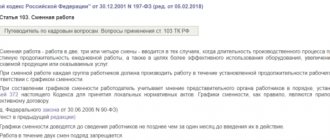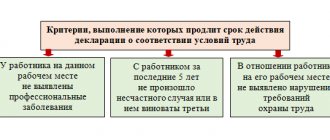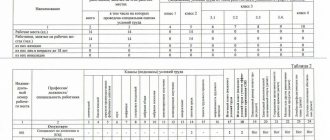The gradation of the degree of harm and danger when performing a specific job or for an entire profession is called classes of working conditions. In the Russian Federation, four such classes have been created, the decoding of each of which designates and establishes harmfulness. The first is the least harmful, and the fourth is the most. The assessment of the insurance premium for the worker, the required vacation, compensation for harm and the frequency of medical examinations depend on this. Class 2 working conditions means that the employee is not at risk and is in an area with acceptable working conditions.
Existing degrees
Today there are four classes of working conditions. This division began with the adoption of the new Labor Code of the Russian Federation, in which for the first time a gradation of professions and work appeared according to degrees of complexity, danger and harmfulness. All kinds of additional payments, benefits and additional preferences depend on this division.
Note! Before the general knowledge test, preliminary target classes are created in the organization.
All requirements and rules are presented in Federal Law No. 426-FZ. It says that all production factors begin to be divided into four classes:
- the first represents optimal working conditions;
- the second relates to permissible conditions;
- the third class indicates that the employee belongs to an area with hazardous conditions;
- the fourth is called hazardous working conditions.
Note! The last class may be characterized by the most harmful and complex aspects. For example, working in the chemical industry.
In general, this is called a special assessment of working conditions or SOUT. It should be performed once every five years or more often. All companies and organizations must comply with it, regardless of the number of employees. This does not apply only to individuals working remotely.
Conducting a special assessment of local working conditions for workers with disabilities
When dedicated jobs are created for disabled people, their special assessment is carried out in accordance with the provisions of Federal Law No. 426-FZ. Particular care must be taken when assessing the results of this procedure. In particular, make sure that the working conditions in which such a specialist works comply with his individual rehabilitation program and the requirements of Sanitary Rules SP 2.2.9.2510-09, which determine acceptable working conditions for this group of employees. According to Section 4 of this regulatory document, it is prohibited to attract workers to work if the conditions at their workplaces do not comply with established hygienic standards and have a pronounced negative impact on their health.
When you can't work
It is not allowed to organize the work of disabled people in places characterized by an increased influence of the following harmful and dangerous factors:
- physical factors, including noise, increased air temperature, vibration, etc.;
- chemical factors, including air pollution in the work area, the presence of harmful chemicals in the work area, etc.;
- biological factors, including pathogenic flora and microorganisms in contact with the employee’s body;
- nervous and mental stress, including a high degree of monotony of work, significant emotional overload, etc.
If a special assessment of the working conditions of disabled people has been carried out and the positions of employees with health restrictions are found to be optimal or acceptable, they will continue to work under the same conditions. In this case, information about the established class of their working conditions is included in the employment contract. In addition, the employer submits a declaration to the territorial division of the State Labor Inspectorate confirming the compliance of working conditions at a given place with current standards.
How much to pay for injuries
Based on the results of a special assessment and taking into account the presence of a confirmed disability group, the amount of insurance contributions paid by the employer to the Social Insurance Fund for injuries is determined. For employees of this category, they will be 60% of the tariff established for this organization. For other insurance premiums paid to the Social Insurance Fund and the Pension Fund of the Russian Federation in 2021, their amount is:
- in the Pension Fund of Russia - 22% - the tariff is valid until the income limit is reached, which is 1,150 thousand rubles (after payments to the employee exceed this amount, the rate of contributions to the Pension Fund of the Russian Federation is reduced to 10%);
- in the Social Insurance Fund - 2.9% - after reaching the income limit set at 865 thousand rubles, contributions are not accrued;
- in the Federal Compulsory Medical Insurance Fund - 5.1% - for this category of contributions the maximum amount of income is not defined: they are paid from any amount of amounts paid to employees.
Thus, the employment of disabled people, which is the responsibility of all large employers, imposes additional conditions on the organization in terms of organizing their work. This issue needs to be given special attention, since they are most carefully monitored by specialists from the Labor Inspectorate.
Second class
Quite often, when searching for information on the global network, you can come across the request “class of working conditions 2, what does this mean for both the employee and his employer?” The risk of being in this class of worker is acceptable. However, unlike first class, it does not guarantee complete safety.
Working conditions class 3 subclass 3: additional pay and benefits
All final values and features are indicated in the presented law and have specially regulated criteria for correct assessment.
For the employer and employee, being in the second class means that there is a slight harmful or dangerous effect on the employee’s health, but it is within acceptable limits.
It is generally accepted that any negative impact on the employee’s body is neutralized during rest, therefore the second level does not entail any special occupational diseases. Such an employee is not entitled to bonuses and compensation, as well as an increase in the number of vacation days.
Important! The level is considered to be completely safe, although it has some negative factors. Therefore, the employee is not entitled to privileges.
Assessment of working conditions
It is necessary for the employer to carry out inspections and, based on their results, determine places of work with acceptable conditions. They will remain so for the next five years. After that, he needs to maintain the safety of the places.
For the second level, the employer gets rid of paying insurance premiums according to a special tariff schedule. However, if occupational diseases in people or accidents are detected at such places, an extraordinary reassessment should be carried out.
Legal standards
The Institute for Special Assessment of Working Conditions (abbreviated SOUT) appeared in 2014. Today it is regulated by the following rules:
- Labor Code of the Russian Federation;
- Federal Law “On special assessment of working conditions”;
- Code of Administrative Offenses of the Russian Federation.
In accordance with the Labor Code of the Russian Federation, a study of the degree of danger of work activity must be carried out in relation to each enterprise, regardless of:
- organizational form of conducting activities;
- type of property;
- number of employees.
Conducting SOUT is not necessary:
- when performing work functions remotely (for example, programmers, university teachers);
- in case of work from home (for example, craftsmen, confectioners).
The assessment of the category of work activity is carried out in the interests of the employee.
The legislation of the Russian Federation determines what is due to workers in accordance with the class assigned to their position, namely:
- what compensation is provided;
- what operating mode is set;
- what is the duration of the vacation?
The Federal Law “On Special Assessment of Working Conditions,” introduced in Russia in 2013, divided workplaces into 4 groups depending on the degree of danger.
The first 2 classes are not regarded as dangerous. If an employee has working conditions 1 or 2, no compensation is provided to him for lack of harm.
The characteristics of work in groups 3 and 4 differ in severity. They may pose a risk to the worker's health or threaten his life.
Work in such positions is compensated by:
- shorter working hours;
- salary supplement or payment for sanatorium-resort treatment;
- additional days of vacation.
If an employer evades the mandatory assessment, he may be held accountable under administrative law.
The maximum fine for a first-time violation according to the Code of Administrative Offenses of the Russian Federation is 80 thousand rubles, and the calculation will be made based on the number of positions that have not been assessed.
In case of repeated violation, the manager faces disqualification, and the legal entity faces suspension of activities.
Limit limits
SOUT: special assessment of working conditions
The boundaries in the presented case are quite thin. If the working conditions are recognized as SOUT class 2, which means acceptable, then the next, third level will already indicate harm to the human body. In this regard, the harmfulness for each class is divided into four subclasses:
- hazard class of the first degree. Indicates that the work performed increases the risk of damage to the body, which cannot fully recover from shift to shift;
- second degree. It says that after 15 years of constant work, an occupational disease of mild severity may be discovered, that is, the professional ability to work will not be lost;
- third degree. Indicates the possible development of an occupational disease with a severity level that is considered moderate. The ability to work will be lost in a professional direction;
- fourth degree. There is a possibility of manifestation of an occupational disease, which has serious consequences, which are accompanied by a complete loss of ability to work.
Note! That is why the SOUT was created with the main goal of identifying the most vulnerable limits and boundaries. This will allow employees to be compensated for any costs that may affect the condition of their body.
According to the degree of danger and harmfulness, working conditions are divided into four classes.
Optimal conditions (1st class)
The optimal class includes those working conditions in which the impact of harmful or dangerous factors is absent or does not exceed the levels prescribed in the standards of working conditions and recognized as safe for humans; at the same time, the prerequisites are created to maintain the employee’s performance at the proper level.
Acceptable conditions (class 2)
Acceptable working conditions include working conditions in which the employee is exposed to harmful or dangerous production factors, but the levels of such exposure do not exceed the levels prescribed in hygienic standards, and the altered state of the employee’s body completely returns to normal during the process of regulated rest or by the beginning of the next work shift .
Harmful conditions (grade 3)
Harmful working conditions include conditions under which the level of exposure to harmful and dangerous factors exceeds the levels allowed by hygiene standards.
Subclass 3.1
Harmful working conditions of the first degree include conditions under which the employee’s body is exposed to harmful and dangerous factors, after which the altered state of the body must be restored over a longer period than is available to the employee before the start of the next shift, or when the influence of these factors ceases, and also which increases the risk of harm to health.
Subclass 3.2
Harmful working conditions of the second degree include conditions under which the worker’s body is exposed to harmful and dangerous factors that can lead to permanent changes in the worker’s body and contribute to the development of occupational diseases at the initial stage or to a mild degree (without loss of ability to work) subject to long-term exposure - fifteen years or more.
Subclass 3.3
Harmful working conditions of the second degree include conditions under which the worker’s body is exposed to harmful and dangerous factors that can lead to permanent changes in the worker’s body, contributing to the development of occupational diseases of mild and moderate severity (with loss of ability to work) during professional activity.
Subclass 3.4
Harmful working conditions of the second degree include conditions under which the worker’s body is exposed to harmful and dangerous factors that can lead to permanent changes in the worker’s body, contributing to the development of severe occupational diseases (with loss of ability to work) during professional activity.
Hazardous Conditions (Class 4)
Harmful working conditions include conditions under which the level of exposure to harmful and dangerous factors during a work shift can create a threat to the life of a worker, and the consequences of their exposure increase the risk of developing an acute occupational disease during professional activity.
Occupational Safety and Health
Classes of working conditions according to the degree of harmfulness and danger
In the course of identifying dangerous and harmful conditions, the occupational safety officer conducts an assessment and establishes a class. Subsequently, all these results must be compared with hygienic criteria for the distribution of working conditions according to a variety of standards and indicators, also according to the intensity and severity of the work process. This is carried out in accordance with the special Guide R 2.2.2006-05.
Division by professional activity
All presented criteria are based on the distribution of working conditions according to the degree of deviation of the parameters of the work process and the production environment from the developed hygiene standards and the impact of deviations on the general condition and performance of personnel. This is how the division looks from a labor safety point of view.
Working conditions and intensity
To characterize the place of work, determine the standards and area of responsibility of the employer, processes should be divided into classes according to the degree of harmfulness. Determine which jobs are subject to a special assessment of working conditions. Standards are needed to improve production safety and determine the ratio of work and rest time.
The manager, on the basis of Article 212 of the Labor Code, is obliged to organize:
- safe working conditions for personnel;
- safety training for each team member followed by certification;
- access to trained personnel;
- staff work schedule taking into account employment and rest standards;
- reasonable level of work intensity.
The developed measures are aimed at maintaining the employee’s labor activity.
Medical examination for second level personnel
Personnel who have received the second degree of working conditions are not required to undergo periodic medical examinations. This should be established at the state level and mean that there is no need for passage. Therefore, this condition was confirmed by the Rospotrebnadzor organization in 2015.
It states that persons with harmful and dangerous conditions in the work environment should undergo regular medical examinations. As well as persons associated with transport traffic. This is done in order to identify the ability of workers to perform tasks normally and prevent occupational diseases.
Entry in the employment contract
Supervisors ensure that data on negative factors is included in contracts with employees. Information about dangerous conditions is entered into the contract in the same way as a special assessment card. From page 40 of the special assessment card, guarantees and compensation payments are included in the contract. The amount of compensation payments depends on the class of working conditions. If the special assessment is not completed, the parameters of the work area are entered into the contract.
Employees whose work comes into contact with contamination are prescribed a clause in their contract regarding the provision of detergents and disinfectants. The standards were implemented by order No. 1122 n dated December 17, 2010 by the Ministry of Health and Social Development of Russia.
The data is entered into the employment contract, considering those employed before 2014.
Factors
The production environment is divided into several factors: physical, chemical and biological.
The first, that is, physical, include:
- aerosols or dusts that have a fibrogenic effect;
- high noise levels;
- infrasound and air ultrasound;
- general and local vibrations;
Visual display
- electromagnetic fields with no ionizing nature;
- ionizing and non-ionizing types of radiation;
- microclimate levels, which are assessed by the following parameters: heat radiation, speed at which air moves, temperature and humidity;
- lighting environment with important evaluation parameters: natural and artificial lighting.
Chemical substances usually include the presence of harmful substances in space, which also include those obtained as a result of biological origin or as a result of synthesis.
The latter, biological ones, include all kinds of microorganisms, spores and living cells that are found in bacterial-based preparations.
The labor process is divided into two factors:
- the first characterizes heaviness. Shows the level of load that is carried out on various mechanisms of the human body and its musculoskeletal system. That is, on all systems with the help of which a person’s ability to act is ensured;
- the second indicates tension. Shows the level of load on the senses, emotional direction and impact on the central nervous system.








